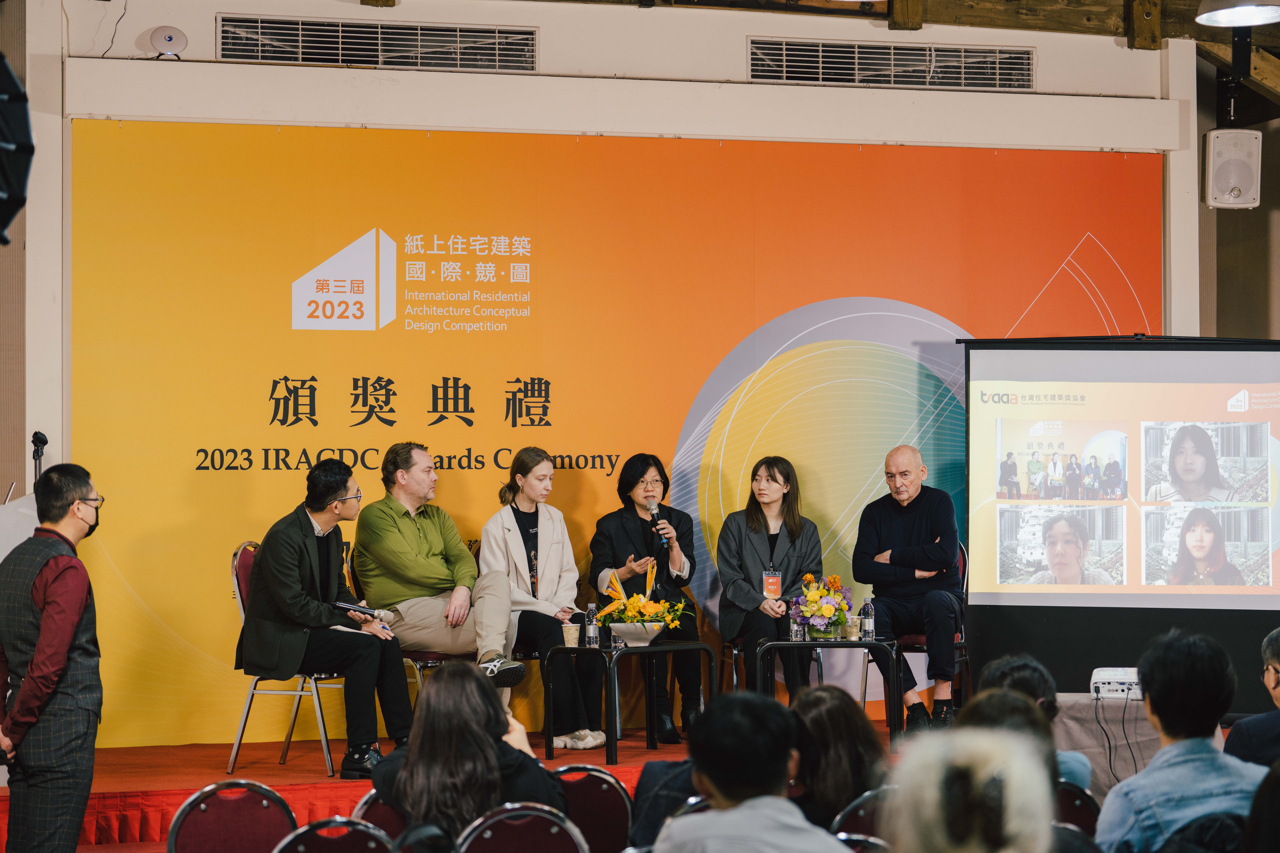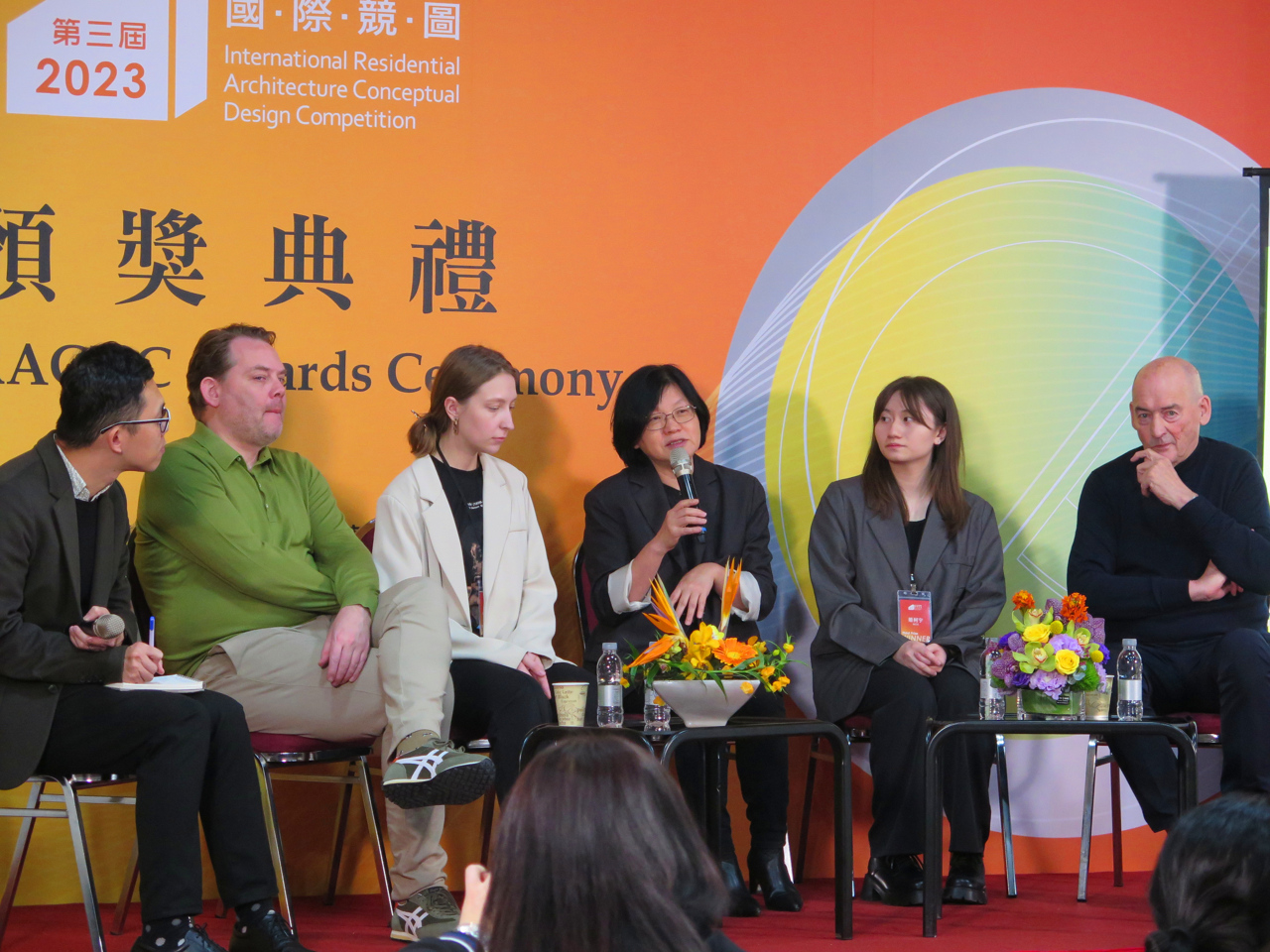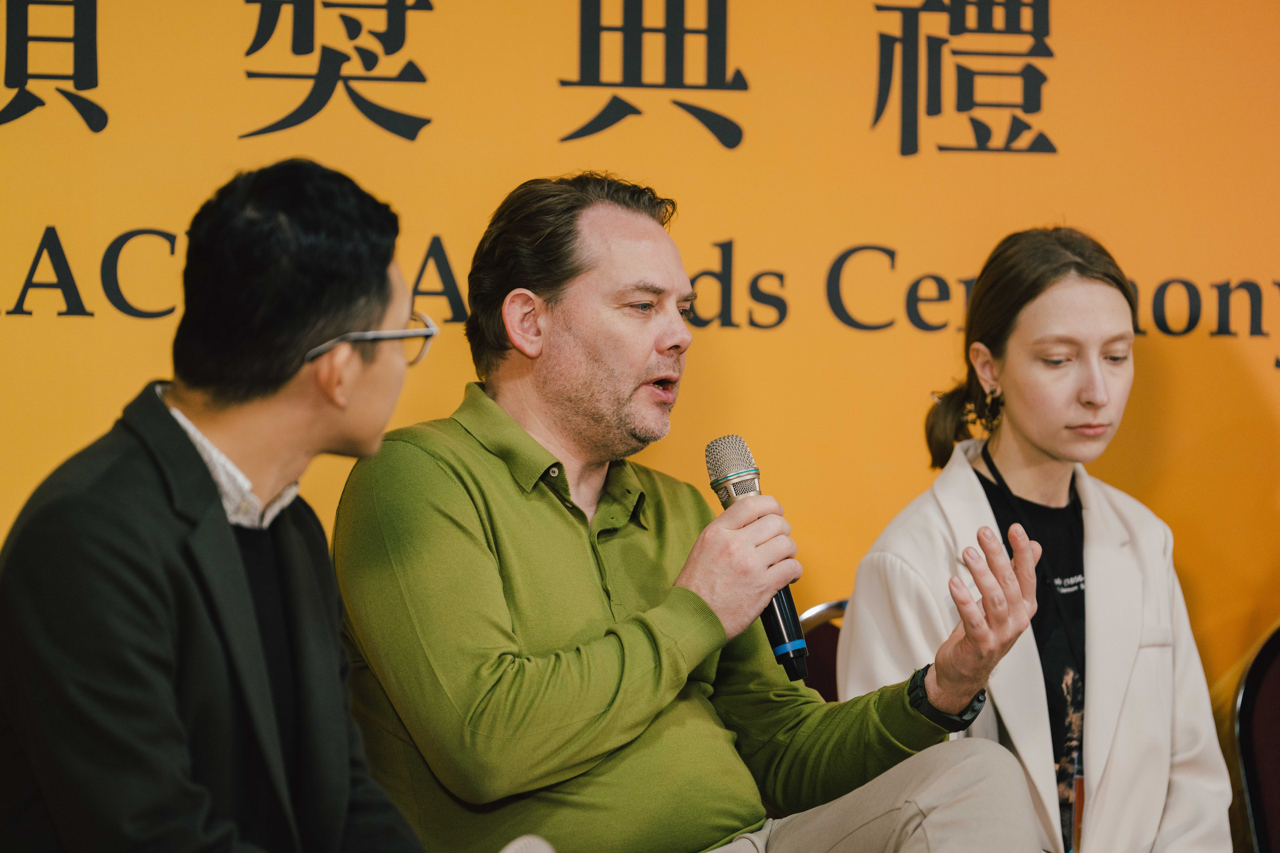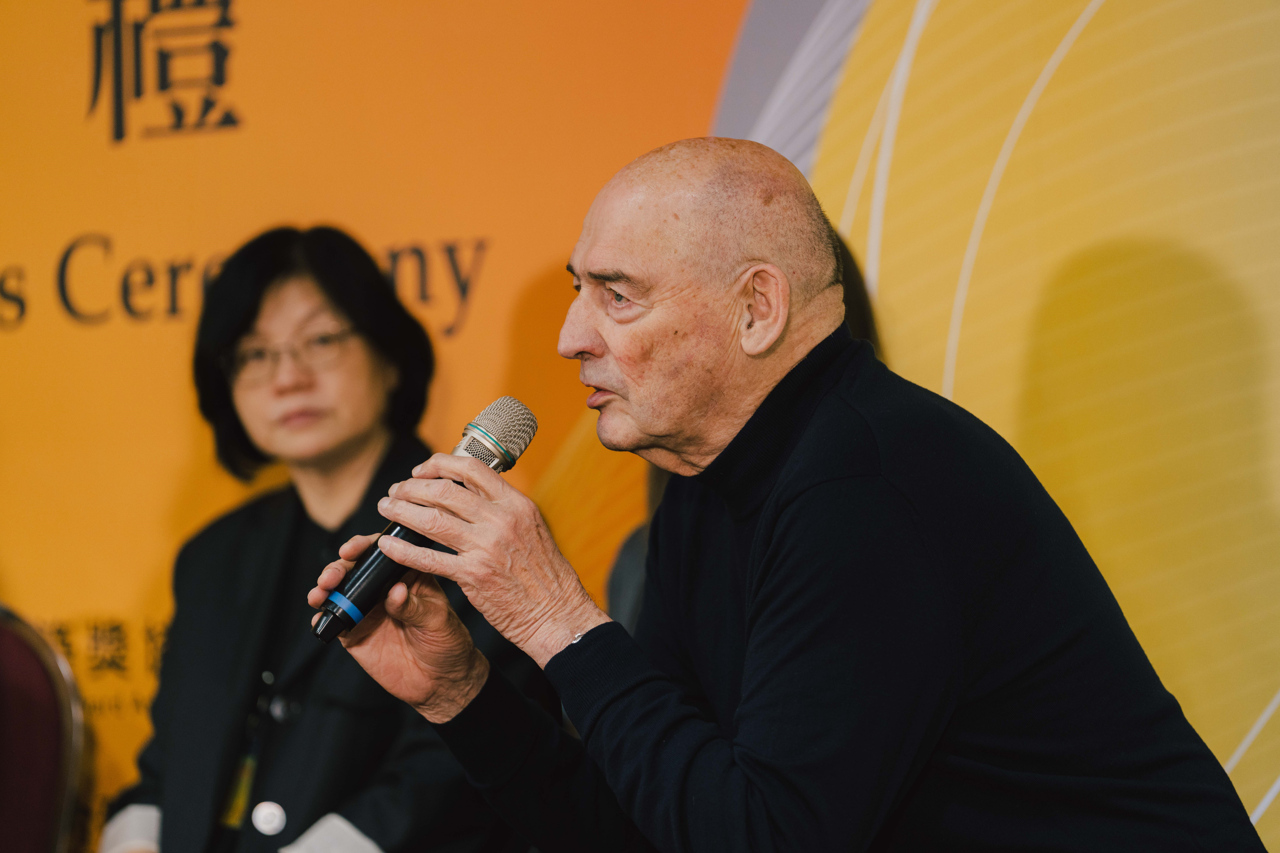時 間:2023年3月19日
地 點:台北市市長官邸藝文沙龍表演廳
>與談人
雷姆.庫哈斯/OMA大都會建築事務所始創合夥人(簡稱-Rem)
大衛.希艾萊特/OMA大都會建築事務所管理合夥人(簡稱-David)
黎淑婷/逢甲大學副校長、教授兼建築專業學院院長(簡稱-黎)
>得獎人
首 獎:段艾辛、耿睿佳、陳麗穎(簡稱-段、耿、陳)
第二名:Алиса Романова(簡稱- Алиса)
第三名:姫柯宇(簡稱-姬)
主持人:王進坤/台灣住宅建築獎協會秘書長(簡稱-王)
現場口譯:錢佳緯
翻 譯:蘇琨峯

頒獎典禮現場實錄
Live Record of Awards Ceremony
https://www.youtube.com/live/Qkduz9LqCZQ?feature=share&t=5708
王:請Rem跟David分享本次競圖以「多功能永續與健康宅」為題的原因,以及二位在疫情之後觀察到住宅面臨何種挑戰?
Wang:What is the reason judges give the article of The Multifunctional Sustainable and Healthy Home? And what challenges do you observe to residence after the pandemic?
Rem:基本上,我們的意圖不僅是討論Covid-19對建築的影響,而是Covid-19帶來的許多新問題,而建築必須處理這些問題。包含了氣候變化、永續、家庭主義及其他嚴重的議題。但我發現有趣的是建築設計在這一世紀中,首次因為外部壓力而需改變。這是建築所面對的全新需求的情況,是一次出現的緊迫政治議題。我認為這是一個附帶效應,但也是一個重要的影響,就像我們與遠端參與者如學生一起進行這項工作,因為你們跟我們都在處理這議題,可說是個新議題。在某種程度上是建築領域的新民主主義,因為我們都在掙扎著解決同樣的問題,也都處於劣勢,但也是我們有更新與創新建築的機會,這已經發生很長一段時間,所以就以此為本次競賽的主題。
Rem:Basically our intention is not only to talk about the effect of Covid on architecture but the all aware part of Covid huge number of new issues architecture has to deal with. The issue of climate change, issue of sustainability, issue of familyism and whole serious of other issues. But I find interesting about the situation architecture is actually for the first time in maybe a century changing because the pressure from the outside. It is the simply the case of completely new demand of architecture. And it is the way very urgent it is kind of political issue also kind of the first time. And I think it is the side of effect but important effect that we do it with distance participants like students because you are dealing with the issues also we are dealing with the issues. And the issues are new for you also are new for us. It is kind of new democracy of architecture in a certain way because we are all struggling with the same questions. We are all disadvantage in situations of same questions. But we also have opportunities to refresh our architecture and invent new architecture. It has been happened a very long time so the context I do with this competition.
David:不知道你們在Covid-19中看到了怎樣的變化。我認為有趣的是,也許已經有一種加速變化的可能性正在進行。而且人們更加意識到,這些問題不能緩慢發展而是需要進行根本性的改變。這與下一次疫情的可能性無關,而僅僅是瞭解到自然界比城市和我們更強大。這也意味著處理不是把自然排除在城市之外,而是歡迎它,讓它成為我們環境的一部分。這不但要精心打理,也是透過微小力量或生產花園的可能性的重要議題,是一種新的關係。我們看到的實際上是全球都有類似的反應,而對於其他的疫情經驗則非常不同,它仍然在世界各地不同。因此,很清楚地沒有一個解決方案適用於所有情況,氣候的不同、文化的差異以及人們處理,或害怕疫情的方式也都不同。
這變得非常非常不同,因此需要對城市和鄉村的回應,這種回應再次變得更加緊迫,因為人們由於同樣的原因從城市搬回鄉村。我認為這是我們想分享的內容,這實際上非常重要。因此,我認為建築設計不應該只提出一種解決方案然後就可解決問題。現在,真正的挑戰是與某事、地區與想法互動,發展出一個適合當地、適合當下的解決方案,而不是只用一種方式就能完全解決一切,因為那樣不會產生正確的效果。
David:The only thing that I would like to say is what kind of changes you see based on the pandemic. I think what is interesting is that maybe acceleration of change possibility already on its way. And people are more conscious these items cannot be developed slowly but really needs to be a radical difference nowadays. That is not related to potential for next pandemic but simply related to realize that nature is stronger than our city and stronger than us more and more. And that also means that dealing with nature is not keeping it outside of the cities but actually also welcome it in and make it to be part of our direct environment. Not in a manicure way only but also really in a rough sense through micro force or through the possibility pf production gardens. And which something is new relationship.
And we see actually is all parts of the world that is really response everybody gets in the similar way. For the rest experiences of pandemic was very different all around the world. And it is still different all around the world. So that is also kind of very clear the idea or one solution for all. It is not possible. The difference in climate the difference of culture and also the difference of in the way people deal with it or maybe afraid of it. It is very very different and therefore require it from urban and also response to the country side which has become more pressing again. Because people are moving from the city back to it for the same reason. And I think that something we would like to share the context. It is actually very very important in this situation. So I think architecture is not thinking about one solution that can be role out and then we have solved it. Now it is really about engaging something and engaging with the area engaging with the thought. And then developing to gather a solution that works at that spot works for that moment instead of thinking as we now we need to do everything differently and needed to do in one way because will not give the right effect.
王:黎淑婷副校長前幾年跟半畝塘團隊,一起合作出版《節氣、意境、整全性:五度空間的建築》,還請分享台灣在地建築團隊面對疫情,是用怎樣的方式來回應?
Wang:We just mentioned about locality. We know that Vice President lee had worked with the Banmu Architects a few years ago to publish a book on seasonal architecture. Can we discuss how our local team faced this challenge during the pandemic?
黎:我們早在十多年以前就跟半畝塘合作,一起思考好的建築,需要具備什麼特質?怎樣的建築可以回應社會?其中,健康跟環境合作是重要的核心。之後我們即開始透過許多機制跟軟體,以對環境負擔最低的方式,採被動式、最自然的建築方式去回應,讓建築和環境達到平衡。那建築應扮演怎樣的角色?我們認為建築透過薄的皮層,同時回應裡面的生活需求及外部自然環境,內部涵養的是生活,外面尊重自然,達到最好的建築,在這薄薄的皮層中,用自然的方式去回應。台灣長期喜歡用磁磚,但經過研究發現磁磚的碳足跡很高,因此半畝塘之後就不再用磁磚,用別的方式替代。再來,我們也關注回收材料,包括研究將蚵殼廢棄物轉為建築材料,與水泥結合成為地磚。除了材料外,透過皮層引進氣流來改善溫濕度,用自然的方式打造更健康的建築。回看十多年來,半畝塘持續的精進跟演化,並且不藏私地透過出版分享研究成果,關鍵在有良好的態度面對挑戰,才能跟著時間演進面對挑戰提出解決方案。
Lee:Although this design topic is related to the pandemic, we have been working with Banmu Architects for over ten years to discuss the health issues. At that time, we were already thinking about what qualities a good building should have if we were able to build one today. Of course, health is definitely one of them, and environmental cooperation is also one of them. Ten years ago, we have proposed what kind of building could respond to this society. All the way, we have implemented many mechanisms, and even the software currently used was launched ten years ago. What is the way to minimize the environmental fburden? Can we describe it through passive house design in architecture to achieve this goal? How can we achieve the best balance between the building and the environment as the most natural way? I learned an important classic through collaboration with Banmu which I would like to share again- What is the role of architecture? Architecture is just a thin layer of skin. Its expression responds to the needs of living inside and the natural environment. Therefore, life is contained inside, while the outside respects nature. Architecture should follow this spirit in order to achieve the best building. So, besides the concern from society and nature for the passive architecture, we try to use more natural methods in the thin layer of skin. For example, in Taiwan, people like to use tiles, but we found that the carbon footprint of tiles is very high after our research. Therefore, Banmu has not used tiles in its buildings in recent years. If you're interested, you can check what alternatives to tiles are used in Taiwan. I won't give you the answer yet because in this way everyone can do some researches. About a more eco-friendly way is to use recycled materials such as a large amount of oyster shells. Oyster farming produces a lot of waste oyster shells which can be used as building materials. How to use oyster shells and cement to make floor tiles and how to create better temperature and humidity through microclimate airflow for a healthier living environment. Lock down will not be a better solution but giving a more natural way to bring a healthier architecture. Ideas like this are constantly improving and evolving through collaboration. So if you have the opportunity, go to look at their architecture, and check out a series of books on this type of architecture published by archi-tec. I think the details inside when talking about a good architecture which should constantly improve and evolve through continuous dialogue and requirements instead of a solution. I think when you have a good attitude to face it the attitude and solution will emerge with different solutions and answers over time.

Lee, Shwu-Ting/photo: ta-Wu
王:首獎團隊,妳們觀察中國當代住宅建築受到怎樣的挑戰?
Wang:What kind of challenges did the three first-prize winners observe for contemporary residential architecture in China?
耿:我們是從城市做為出發點,考慮如何將鄉村的生活方式移入城市,很認同競賽宣言中表示的改變應該由下而上,我們是位於中國重慶,在重慶會看到許多高樓跟老城區的混合,兩者的反差帶來強烈的衝擊。而且有許多農民工從鄉村來到重慶,提供底層的勞動基礎,但始終住在城市的邊緣區,城市應提供人們更好的生活,但矛盾的是並非每個人都享受到,因為疫情的爆發更凸顯中國忽視農民工現象的問題。在疫情後也發現城市中的生活開始倒退,為了減少和外界接觸,人們在家的時間變長,有些人開始種菜,自己烹飪料理,進行個人的生產行為,減少疫情的波及,反而回到了過去。而這樣的居住模式讓我們聯想到鄉村自給自足的生活模式,透過這樣由下而上的方式試圖改變當下居住問題。我們認為疫情不是單一問題,更可能是個機會,看到全球城市化背後生活方式及居住空間的弊端,而鄉村本身內含一種顛覆的潛力,利用其自發性的力量,或許可為未來城市生活做出貢獻。
Geng:We start from the city then consider how to bring rural lifestyles into the city. Our starting point is that we saw the real change should come from the bottom up in the competition topic. We have the feeling from this point. Because we are in Chongqing, China, we often see the mix situation of developed high-rise buildings and old city areas, which creates a strong impact. In Chongqing, there are many migrant workers from rural areas who provide the labor foundation for the city, but they always live in the peripheral areas of the city. I think this contradiction arises from the fact that the city should bring a better life to people. Therefore, our proposal is rooted in China's neglect of migrant workers in cities, and the pandemic has highlighted this issue significantly. And we discover an interesting phenomenon from observing people's lives during the pandemic that there has been a kind of retrogression in urban living. We see that people are spending more time at home, trying to minimize contact with the outside worldf. Some people even grow their own vegetables at home and cook their own meals instead of ordering takeout. This personal production behavior has emerged because it will not take impact of the pendamic. The service industry in cities has returned to a lifestyle similar to that of the mass industrial production era. This living pattern also reminded us of the self-sufficient lifestyle in rural areas, which connects to the issue of how to change our living patterns from the bottom up. We believe that the pandemic is not a problem, but perhaps an opportunity that allows us to see the drawbacks of the lifestyle and space behind global urbanization. So it is possible to utilize the spontaneous power of the rural areas to bring opportunities, and perhaps the rural areas themselves contain a subversive potential that can contribute to the future of urban life. This may also lead to some new ideas.
王:Алиса的住宅作品展現內聚,向外的窗戶尺度小,與台灣所屬的亞熱帶不同,不知道俄羅斯是怎麼面對Covid-19的挑戰?
Wang:The design of winning entry is particularly cohesive, and the windows on the exterior are relatively small, which is quite different from the design of buildings in tropical countries like ours. How has Russia responded to the challenges of housing and the pandemic?
Алиса:2020年時是比較嚴重,但現在沒事了。我們戴口罩,但有時會忘記保持距離,我認為這不是正確的方法,需要從錯誤中吸取教訓,用這個危機來改善生活,創造有微氣候的住宅。
Алиса:It is not serious. It was serious about in 2020 year but now it is ok. We have done with masks. We forget about some distances and I think it is a .. not go to the way but we need to teach of our mistakes to use our information for improving the situation to for improving to the house living. And to use the information or creation the residential houses with micro climate inside.
David:過去三年來,Алиса的城市發展是否因氣候問題、疫情或人們希望如何共同生活而發生變化,特別是年輕一代有不同的需求嗎?是否看到變化或是促使了變化?
David:We are thinking that the development in your city is changing over the last three years because of the climate issues or because of the pandemic or the way people wat to live together upon the younger generation probably has different demands. The people establish the city. Do you see chang and do your provoke change?

David Gianotten/photo: OS Studio-Neo
Алиса:我們有獨特的發展系統。整個城市的命運掌握在政府手中,未經他們批准就不能建造任何建築。在經過疫情後,有了些改變,開始關注一些規定,並嘗試運用疫情期間的想法來改善建築,目前還沒有很大的不同,但正在加速進行,未來幾年政府將進一步改善。或許莫斯科有比我居住的城市有更多資金用來建設,但我認為這種情況在整個俄羅斯都存在。我們與政府有一種奇怪的距離感,對俄羅斯的建築師來說,要對開發商提出建議是很困難的,他們應該要進行大量的討論並聆聽對方想法,去改變人們的生活。
Алиса:We have unique system of development. The whole of our cities on their hands and then you cannot build something without their approve. And after pandemic we a little bit change. We open our eyes to some of rules. And they are trying to some pandemic ideas to improve buildings. And it is not .. I think we go faster but in the next years I think they can improve. Maybe Moscow gets more money than my cities to build something but I think this situation is the whole Russia. We have strange kind of distance and our architects it is difficult for our architects to say something to developers. And they need to speak a lot to have discussions to hear each other and to try to change the life of the people.
姬:台灣地形狹小,人口又多,所以建築難往水平發展,多朝向垂直性,但垂直的話就較難有包容性提供給大眾使用,要如何才能讓建築有更多包容性?譬如摺疊城市嗎?
Chi:Taiwan's terrain is relatively narrow with large population, so the amount of construction cannot develop horizontally. It may need to be vertical, but vertical design may have some obstacles, and may not have as much inclusiveness for all people in Taiwan. My question is, what kind of architecture can be more inclusive? Is it like a folded city?
Rem:如果從技術角度出發,一名英國教授曾計算過所有模型,是能在低層建築和高層建築中的空間容納相同數量的人和活動。在某些情況下,垂直建築是公家的,但實際上並不必要。但在我們當前的系統中,我認為政府應減少控制而非實施更大型的城市運營規劃。所以我想說,這幾乎是一種經濟上的著迷,讓垂直城市成為可能,而不是順序上的必要性。我曾寫了一本不那麼暢銷的書《摧毀摩天大樓》。雖然不暢銷但我認為已足夠用來反對摩天大樓,永遠不需要垂直建築,除是為了獲利模式外,我認為應朝這方向進行。
Rem:I think if you look tecnically and being an English professor who has calculated all the models. You can easily accommodate the same among of people and same among of activities in low buildings and in high buildings. And in so some examples vertical buildings are official and are never really necessary. But in our current system I think they require less control and less oversize than larger and bigger urban operations. So I would say it is almost the kind of obsession of ..the economic obsession to suit responsible for the kind of vertical city and not any order necessity. I think I have written the totally unsuccessful book 《Kill the skyscraper》. And I knew it is not successful but I think it is enough actually kind of arguing against skyscraper. And make it a same situation that is never a need for a vertical architecture. Except maybe for profit and I think we could make some progress.
David:如Rem所說,我們來自一個有1,900萬人口的國家荷蘭。但垂直建築幾乎不存在。而且西部地區是世界上最密集的地方之一。人們簡單地住在低矮的房屋中。因此我認為在市場的思維下,也有著不同住宅模式的可能性。而且特別是合約上的思維,因建築行業需要不斷發展,業主想要可一直重複的方式,而不是因基地不同有不同形式。如果我們能打破那種模式,那垂直建築就不再是必要的模式,並能得到相同的經濟和相同的密度,也可真正接近大自然,並在空間中擁有自然。例在阿姆斯特丹的項目中,展示了我們試圖將垂直元素拆解成各具自己角色的部分。當市場思維影響減少時,應朝這個方向思考。現在疫情之後也成了經濟上的思考方向,人們開始重新思考模型,並利用這個機會思考如何跳出固有的思維方式。因此作為規劃者、學生和教授,需要利用這個時刻來創造新模型,讓這些新模型能容易地被執行。
David:And to support what Rem said we are coming from islands which is a very tiny country with 19 million people by now. But vertical building is almost absent. And the west part of the country is one of the most dense places in the world. People simply live in the visual low houses. So I think it is the possibility of seeing different models as been raised by the market thinking. And by the way especially also the contract thinking, because the way of building industry needs to keep on going. And they want to repeat and repeat and repeat rather than individual influence. And I think if we are able to crack that model and then the vertical building is not necessary the model any more. You can with the same economic and the same density. Also kind of really reach out to nature and give nature for our place. For example in Amsterdam project I show you also we try to really break the verticality into pieces that each has their own role place. And I think the think in that direction we increase when the market thinking less influence. Now after the pandemic it is like intention of economics. You see the people are open to rethink models and also use the opportunity to think of how we can be out of the singular way we think. So we architects as a planner, students and professors really need to kind of use the moment and also simply recreate the develop of new models. That can be simply than be implemented.
Rem:最近亞洲的成長比其他地區更加快速,因此舉辦了這個比賽。但若看人口統計數據,中國已減少相當大一部分的人口,因此未來壓力會變小。我認為對於亞洲大部分地區,這樣的人口統計數據也會減少該地區的壓力。而且這壓力會移往中東和非洲,他們的人口正增加中,非洲正試著實行一種每個人都須住在城市中的系統。
Rem:I want to make another point. I think recently the growth in Asia becomes much more intense than anywhere else. And so we are interested in organizing the competition here. But if look at the demographics China lose considerable part of its population so it would be much less pressure to always go like that. And I think for large part of Asia the demographics indicating will be eventually more relaxed situation. And the pressure is going to be in the Middle East and in Africa they are continuing to grow and that is why that is also important to influence the case. Africa try to support kind of system there everyone has to live in the city.
耿:這次競賽我們把注意力放在重慶的農民工上,以他們為焦點延伸到一個宏觀的中國鄉村和城市的關係問題上。但大部份只停在概念的層次上,實際上鄉村該如何進入城市,或鄉村的居住模式要如何提供給城市,最後我們呈現的還是一個高樓大廈的模式,但我們的初衷並非這樣。因此,想請問兩位評審,鄉村的居住模式該是怎樣?有怎樣的可能性介入城市?甚至帶來一種不只是新的可能性,以鄉村生活為主的模式?
Geng:Because in this competition, we focused on the migrant workers in Chongqing and extended our focus to the macro relationship between rural and urban in China.
A large part of designs of us only stays at the conceptual level, but in reality, we should consider how the rural living can enter the city or how the rural living model can be provided to the city. What was presented in the competition is still a high-rise building model, but that is not our original intention. I would like to ask what kind of rural living model should be? What are the possibilities of integrating it into the city? Can it bring not only new possibilities but also a new main model with rural life?
Rem:這答案太長且沒有一個明確的表述,且可從不同角度和層次來思考。我認為這個問題或許會在五年後變得更加重要,且五年後會有更好的答案。我認為我們也不需要驚慌,現在是許多重要問題的緊急時刻,但我們不可能在此刻解決所有問題,對某些問題還必須等待,有點像是在冥想,思考什麼才是最好的方式。
Rem:The answer is too long and the answer is here not formulated. It is kind of something we all can work on in different ways and in different levels. And I think that maybe the question become important in five years, because I think in five years there would be better answers. And I think also we should not panic. I think it is a very urgent time for many critical issues. But I think we should meet we cannot solve them all at this moment. And for certain issues we also have to wait we have kind of meditation you know what would really be the best way.

Rem Koolhaas/photo: OS Studio-Neo
